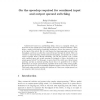Free Online Productivity Tools
i2Speak
i2Symbol
i2OCR
iTex2Img
iWeb2Print
iWeb2Shot
i2Type
iPdf2Split
iPdf2Merge
i2Bopomofo
i2Arabic
i2Style
i2Image
i2PDF
iLatex2Rtf
Sci2ools
AUTOMATICA
1999
1999
On the speedup required for combined input- and output-queued switching
Architectures based on a non-blocking fabric, such as a crosspoint switch, are attractive for use in high-speed LAN switches, IP routers, and ATM switches. These fabrics, coupled with memory bandwidth limitations, dictate that queues be placed at the input of the switch. But it is well known that input-queueing can lead to low throughput, and does not allow the control of latency through the switch. This is in contrast to output-queueing, which maximizes throughput, and permits the accurate control of packet latency through scheduling. We ask the question: Can a switch with combined input and output queueing be designed to behave identically to an output-queued switch? In this paper, we prove that if the switch uses virtual output queueing, and has an internal speedup of just four, it is possible for it to behave identically to an output queued switch, regardless of the nature of the arriving tra c. Our proof is based on a novel scheduling algorithm, known as Most Urgent Cell First. T...
| Added | 22 Dec 2010 |
| Updated | 22 Dec 2010 |
| Type | Journal |
| Year | 1999 |
| Where | AUTOMATICA |
| Authors | Balaji Prabhakar, Nick McKeown |
Comments (0)

